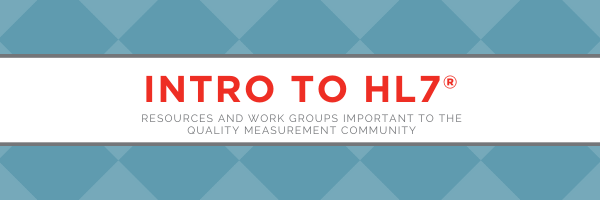
Health Level Seven (HL7®) drives the standards upon which electronic Clinical Quality Measures (eCQMs) sit, so participation in these venues is crucial. The HL7 community already has a lot of technical input but lacks input from the clinical side – either from clinicians or clinical informaticists. There is a gap between the clinical intent of quality measures and the technical standard, but clinical informatics experts can help bridge this gap by contributing to the conversation and development of the HL7 standards and resources.
- Clinical Quality Information (CQI) Work Group – This work group creates and maintains HL7 standards supporting quality measures, evaluation, and reporting of quality data.
- Clinical Decision Support (CDS) Work Group –This work group creates and promotes its standards by working on issues related to single-patient-focused and population healthcare decision support capabilities. It also owns the Clinical Quality Language (CQL) standard.
- Da Vinci - Digital Exchange for Quality Measures (DEQM) – Da Vinci supports the integration of value-based care data exchange across communities. DEQM defines how additional measures will work and create patterns for different types of measures and will replace Quality Reporting Document Architecture (QRDA) formats for eCQM reporting in the future.
- Clinical Information Modeling Initiative (CIMI) – This work group engages with clinical domain experts to improve the interoperability of healthcare systems through shared implementable clinical information models.
- Vocabulary Work Group – eCQMs require the use of standardized terminologies, and this group maintains coded vocabulary terms used in HL7 information structures. The work group maintains the HL7 Vocabulary Model and guidance of the use of vocabularies in HL7 Standards and provides clear guidelines on the principles of vocabulary content to support meaning over time.
- Patient Care (PC) Work Group – This group defines the requirements of and designs/validates standards specifications and implementation guides for the capture, communication, and use of information related to the management, execution and quality of care provision.
- Orders and Observations (OO) – Members of this group define information exchange capabilities to support order/scheduling and clinical event management.
- Clinical Interoperability Council (CIC) – The CIC serves as the liaison between the clinical community and HL7, conducting outreach to clinicians to include their expertise in standards development, and promoting interoperability across healthcare, research, public health, quality improvement, and other health domains through consensus-based standard data elements.
As a measure author, it is important to understand which work group owns the resources used in your measures, and actively participate in those venues. For example, a measure developer working on a measure related to infant breast milk consumption will likely want to participate in the OO Nutrition Sub-Group to ensure this measure concept’s specific use case is represented.
In addition to the HL7 groups mentioned above, there are many resources available to measure developers and implementers to provide additional standards and information to inform and guide the development of eCQMs:
- eCQI Resource Center – This is the one-stop-shop for all things eCQM. This website houses the eCQM specifications (including both previously implemented and current), links to standards—including the Quality Data Model (QDM) and CQL—used to develop eCQMs, educational and engagement opportunities, and news and events. It is meant to provide all of the information or links to information needed to author or implement eCQMs.
- Centers for Medicare and Medicaid Services (CMS) Measures Management System Blueprint (the Blueprint) – Currently in its 15th version, the Blueprint was originally created for those developing eCQMs for use in federal programs. However, the content of the Blueprint has been expanded to apply to all eCQMs, detailing a core set of business processes and criteria measure authors should follow. Within this document, information regarding measure development, specification (including vocabulary recommendations for types of clinical information), and testing are detailed.
- QDM User Group – Participants of this open stakeholder group use their expertise to recommend changes to the QDM based on: 1) measurement needs, 2) real-world feasibility, and 3) harmonization with HL7eCQM and CDS standards. This group is currently mapping the QDM to QI-Core extension (future state of eCQMs).


.jpg?width=100&height=100&name=LISA%20ANDERSON%20(002).jpg)